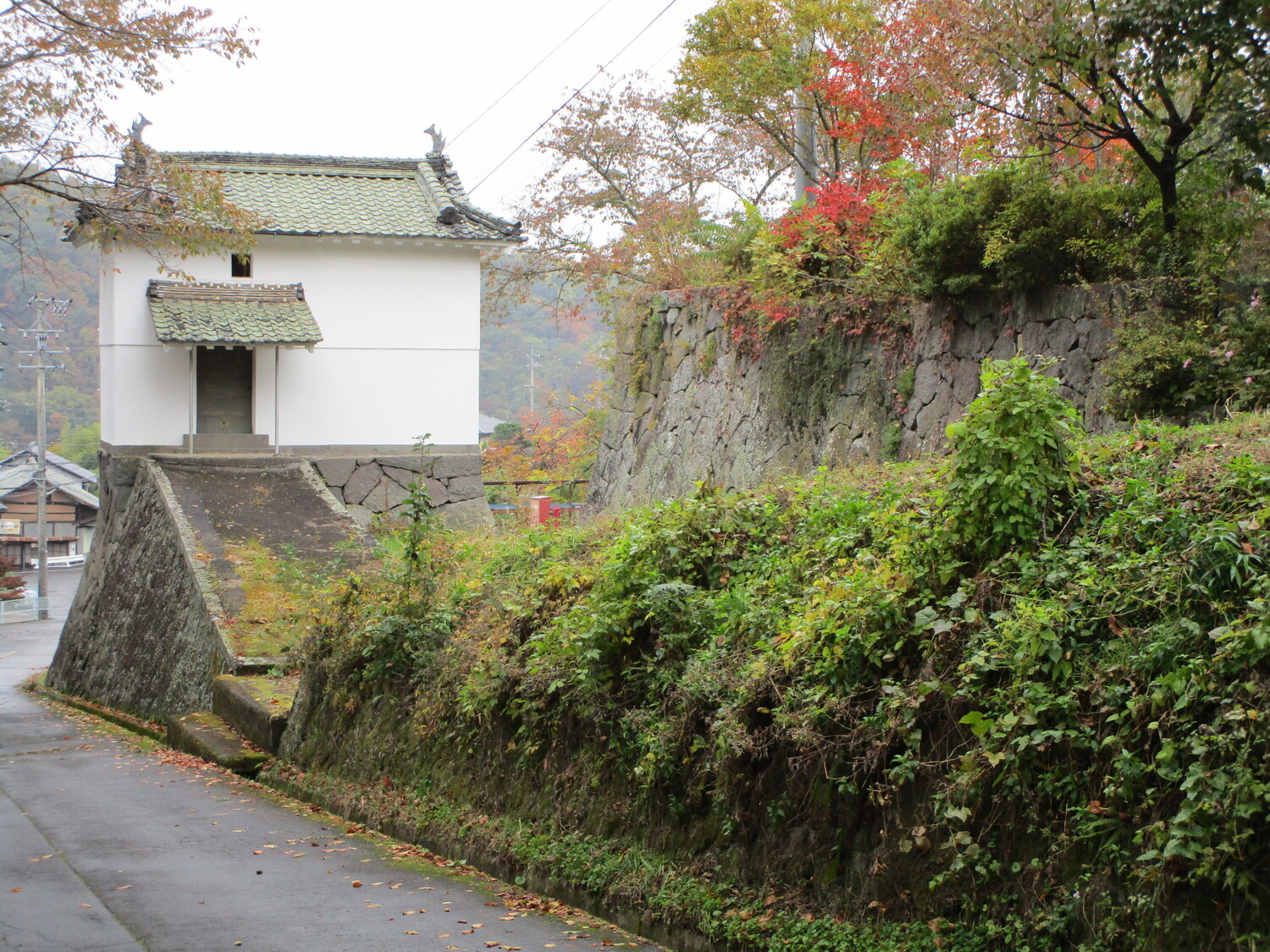Yazawa Jin'ya: Difference between revisions
No edit summary |
No edit summary |
||
| Line 1: | Line 1: | ||
{{Castle | {{Castle | ||
|English Name= | |English Name=Yazawa-jin'ya | ||
|Japanese Name= | |Japanese Name=矢沢陣屋 | ||
| | |Alternate Names=Sengoku-yakata (仙石館); Sengoku-daikansho; Sengoku-jin'ya | ||
|Founder=Sengoku Masākira | |Founder=Sengoku Masākira | ||
|Year Founded=1669 | |Year Founded=1669 | ||
| Line 15: | Line 14: | ||
|City=Ueda | |City=Ueda | ||
|Prefecture=Nagano Prefecture | |Prefecture=Nagano Prefecture | ||
|Notes= | |Notes=This site of an Edo period jin'ya or daikansho, a fortified administrative compound used to govern smaller territorial holdings, was formerly the kyokan (residential annex) attached to [[Yazawa Castle]]. I was impressed by the ishigaki (stone-piled ramparts). These beautiful stone walls are the remains of the jin'ya. One platform of piled stone looks like it could've served as a turret foundation. Atop is a storehouse structure which has been "castellated" and has shachihoko (鯱) on the roof. I'm not sure this qualifies as a reconstruction but it looks great. | ||
A gate remains from the time of the jin'ya, now on private property. | A gate remains from the time of the jin'ya, now on private property. | ||
|History=In 1622 Sengoku Tadamasa was relocated from Komorojō to Uedajō. His territory included this area, which in 1669 Sengoku Masākira built a jin'ya here to administer. This "sub-domain" was valued at 2,000 koku, later increased to 2,700 koku, and contained the villages of Yazawa, Shimosato, Akasaka, Urushido, Iwashimizu, Koida, Mori and part of Hayashino-gō (gō = township / collection of villages). This is a fertile area located to the east of the Kamikawa River. In 1706 Sengoku Clan was relocated to Izushijō, but the branch at the Sengoku-yakata remained in place and governed until the Meiji Restoration. | |History=In 1622 Sengoku Tadamasa was relocated from Komorojō to Uedajō. His territory included this area, which in 1669 Sengoku Masākira built a jin'ya here to administer. The jin'ya was built upon the former kyokan (residence hall) area of [[Yazawa Castle]]. This "sub-domain" was valued at 2,000 koku, later increased to 2,700 koku, and contained the villages of Yazawa, Shimosato, Akasaka, Urushido, Iwashimizu, Koida, Mori and part of Hayashino-gō (gō = township / collection of villages). This is a fertile area located to the east of the Kamikawa River. In 1706 Sengoku Clan was relocated to Izushijō, but the branch at the Sengoku-yakata remained in place and governed until the Meiji Restoration. | ||
|Year Visited=Viewer Contributed | |Year Visited=Viewer Contributed | ||
|AddedJcastle=2020 | |AddedJcastle=2020 | ||
Revision as of 12:39, 7 July 2025
This site of an Edo period jin'ya or daikansho, a fortified administrative compound used to govern smaller territorial holdings, was formerly the kyokan (residential annex) attached to Yazawa Castle. I was impressed by the ishigaki (stone-piled ramparts). These beautiful stone walls are the rema
History
In 1622 Sengoku Tadamasa was relocated from Komorojō to Uedajō. His territory included this area, which in 1669 Sengoku Masākira built a jin'ya here to administer. The jin'ya was built upon the former kyokan (residence hall) area of Yazawa Castle. This "sub-domain" was valued at 2,000 koku, later increased to 2,700 koku, and contained the villages of Yazawa, Shimosato, Akasaka, Urushido, Iwashimizu, Koida, Mori and part of Hayashino-gō (gō = township / collection of villages). This is a fertile area located to the east of the Kamikawa River. In 1706 Sengoku Clan was relocated to Izushijō, but the branch at the Sengoku-yakata remained in place and governed until the Meiji Restoration.
Field Notes
This site of an Edo period jin'ya or daikansho, a fortified administrative compound used to govern smaller territorial holdings, was formerly the kyokan (residential annex) attached to Yazawa Castle. I was impressed by the ishigaki (stone-piled ramparts). These beautiful stone walls are the remains of the jin'ya. One platform of piled stone looks like it could've served as a turret foundation. Atop is a storehouse structure which has been "castellated" and has shachihoko (鯱) on the roof. I'm not sure this qualifies as a reconstruction but it looks great.
A gate remains from the time of the jin'ya, now on private property.
| Castle Profile | |
|---|---|
| English Name | Yazawa-jin'ya |
| Japanese Name | 矢沢陣屋 |
| Alternate Names | Sengoku-yakata (仙石館); Sengoku-daikansho; Sengoku-jin'ya |
| Founder | Sengoku Masākira |
| Year Founded | 1669 |
| Castle Type | Flatland |
| Castle Condition | No main keep but other buildings |
| Historical Period | Edo Period |
| Features | gates, stone walls |
| Visitor Information | |
| Access | Ueda Station on the Shinano Railway; Sugadaira Bus from Ueda Station No.3 Bus Stop |
| Hours | Free; 24/7 |
| Time Required | 20 minutes |
| Location | Ueda, Nagano Prefecture |
| Coordinates | 36.41332, 138.30825 |
|
|
|
| Admin | |
| Added to Jcastle | 2020 |
| Contributor | ART |
| Admin Year Visited | Viewer Contributed |









